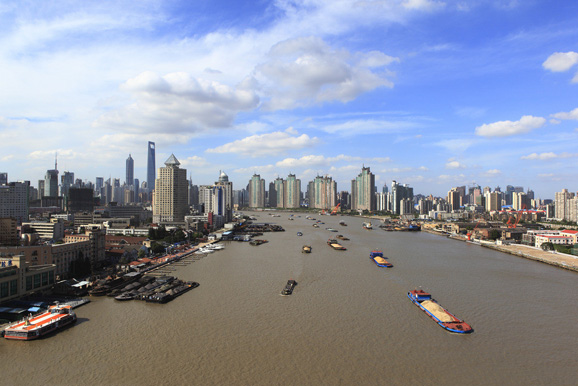Huangpu River water scare in 5 suburbs
 0 Comment(s)
0 Comment(s) Print
Print E-mail Shanghai Daily, December 11, 2013
E-mail Shanghai Daily, December 11, 2013
The water quality on the upper reaches of the Huangpu River is worsening, posing safety risks to Shanghai's five suburban districts that still get their water from the river, local authorities said yesterday.
 |
|
The water quality on the upper reaches of the Huangpu River is worsening. |
The average water quality of the Huangpu River was at third and fourth levels, making it difficult to meet the national standard for tap water resources, a senior official with the Shanghai Water Authority said yesterday.
Some sections of the river even touched the worst fifth level with its deteriorating ammonia and nitrogen amounts, he told local legislative body at a meeting yesterday.
"The upstream Huangpu River is a major river channel for Shanghai and neighboring Jiangsu and Zhejiang provinces with some 700,000 ships passing through every year that impact the water quality," the official said.
The city's Qingpu, Jinshan, Songjiang, Minhang and Fengxian districts still take water from the upstream Huangpu River. Most downtown districts get water from the Yangtze River that has better water quality.
To ensure water safety for the districts, authorities will begin building a small reservoir on the Taipu River to supply water to the five districts. The new reservoir, covering some 2 square kilometers on north Taipu River, can store some 5 million cubic meters of water.
When the water quality worsens on the Huangpu River, the reservoir can supply tap water to residents in the five districts for three days.
Meanwhile, a 44-kilometer-long pipeline, with pipes 4 meters in diameter, will be built to link six different water intakes along the upstream Huangpu River which can be closed during water pollution. Construction of the reservoir and pipeline systems will cost 7 billion yuan (US$1.15 billion) and should be ready by 2017.
Since the Qingcaosha Reservoir went into operation in 2011, Shanghai has been altering its water supply structure.
By the end of 2015, 70 percent of the city's drinking water will be provided by the Yangtze's Qingcaosha and Chenghang reservoirs.
Huangpu will only contribute the rest 30 percent of tap water.
However, the city government is still developing more water resources after a study conducted by a local political advisory body warned that Shanghai may face water shortages if the population continues to soar.






Go to Forum >>0 Comment(s)